# Getting started with Kitsu
With Kitsu, you can collaborate on and track all kinds of productions, including 2D and 3D Production, VFX, Video Games, and more.
It can be as short as a still-frame advertisement or as long as a 3h feature film, from one to thousands of elements.
But before jumping into our production, we must configure our Studio Workflow.
Definition
The Workflow is the coordination of the tasks that make up the work of a production.
For example, you will do the modeling, rigging, and shading to complete an asset in a CGI production.
Definition
In Kitsu, modeling, shading, etc., are called Task Type; an asset, shot, etc., are called Entities. A task intersects a task type and an entities.
The chain of these 3 tasks is your asset workflow. Each task will then be assigned to an artist.
Once you have determined your assets workflow, you will do the same for the shots, sequences, etc.
Once your tasks workflow is defined, the next step is to think about your Approval Workflow. It means to define all the statuses you will use to communicate with your team.
Status will also be useful for tracking the progress of your production.
The Workflow of your production is the sum of your Tasks and Status.
In Kitsu, you have two kinds of libraries:
The first is the Global Library at the studio level. Only the Studio manager has access to it.
The second is the Production Library, where you will pick elements created in the global library to fill out.
The idea is to keep each production separated with a specific workflow.
You can create and modify the department, task type, task status, asset type, and status automation on the Global Library.
You can create as many elements as needed, give the name you want, and choose the best color and options that fit your needs.
Once your Global Library is populated, you can fill the Production Library with the newly created element from the Global Library.
# Create Departments
Departments are here to help the supervisors and artists to focus on their tasks. Once they are linked to one or several departments, supervisors and artists will have direct access to their filtered view, and departments also act on the permissions.
TIP
Per default, Kitsu provides some examples to help you get started.
The department is the first element to set, as multiple other elements (such as people, task type, etc.) are linked.
On the main menu select the
DEPARTMENT page under the Admin section.
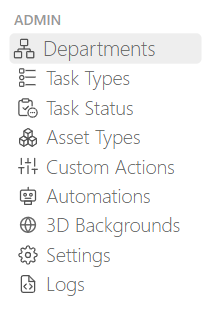
If you need more departments, you can create new ones. Click on the button.
To add a department, you need
- The name of the department
- A color (it will be displayed as a small round next to a column task type or a custom column)

Click on Confirm to save your changes.
Once you finish creating the department, the page should look like this.
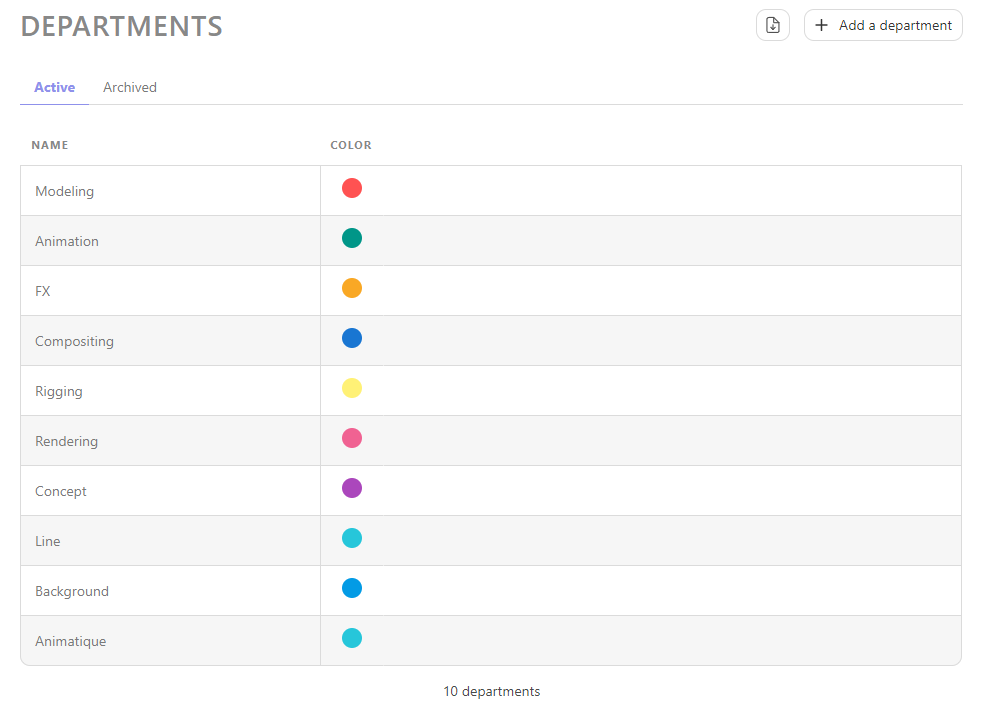
# Studio Workflow: Create a New Task Type
Let's create all the Task Types we need to do and track our production. It could be for the assets, shots, sequences, episodes, or edits.
On the main menu select
the TASK TYPES page under the Admin section.
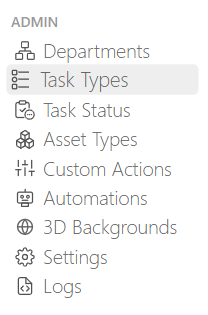
TIP
By default, Kitsu already provides some examples of task types for CGI production.
You can notice these Task Types are already linked to a department.
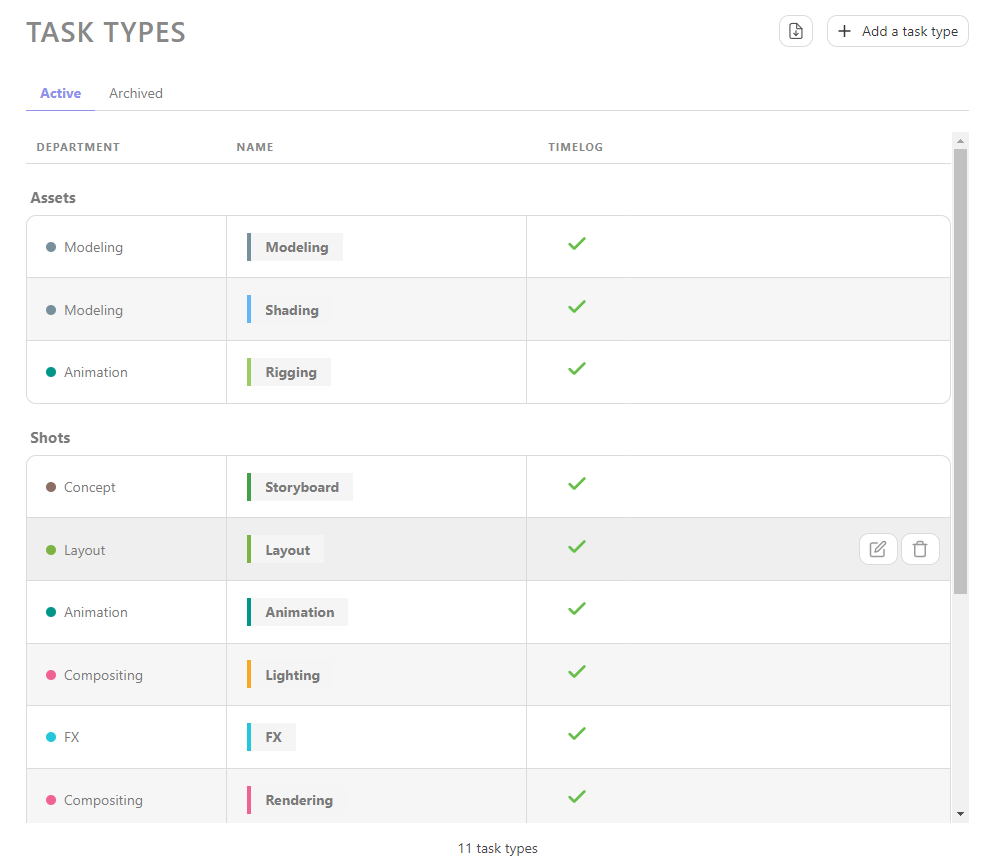
You can click on it to add more Task Type
button.
On the new pop-up, you can define your personalized task:
- The name of the task type
- For which entity it is used
- If the artists need to time log their work for tasks with this task type
- To which department is it linked
- The color (it will be the background color on the main spreadsheet page)
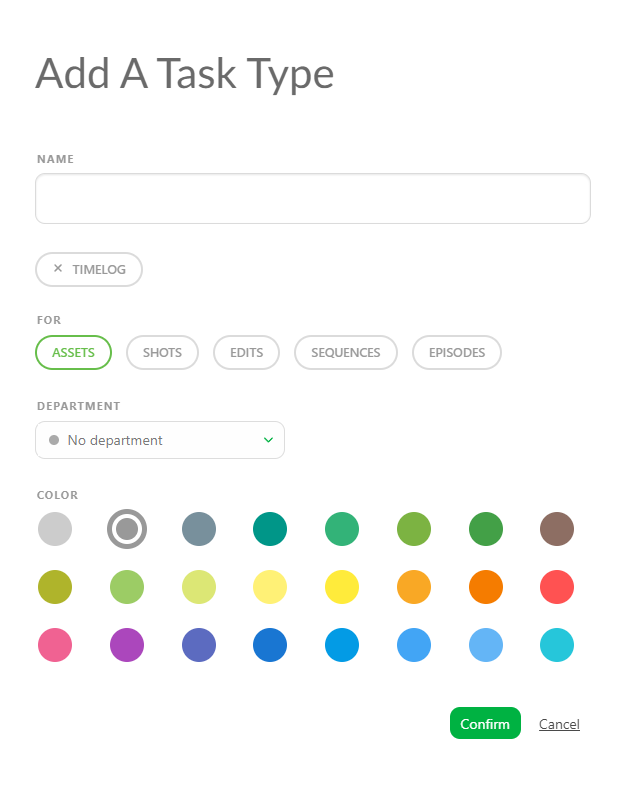
You can notice the Department option. You can select any previously created department to link to this specific task type.
The department will help people and task types to get organized.
Click on Confirm to save your changes.
WARNING
The new task type will be at the bottom of the list.
To change the order, grab the Task Type and move it to its rightful place.
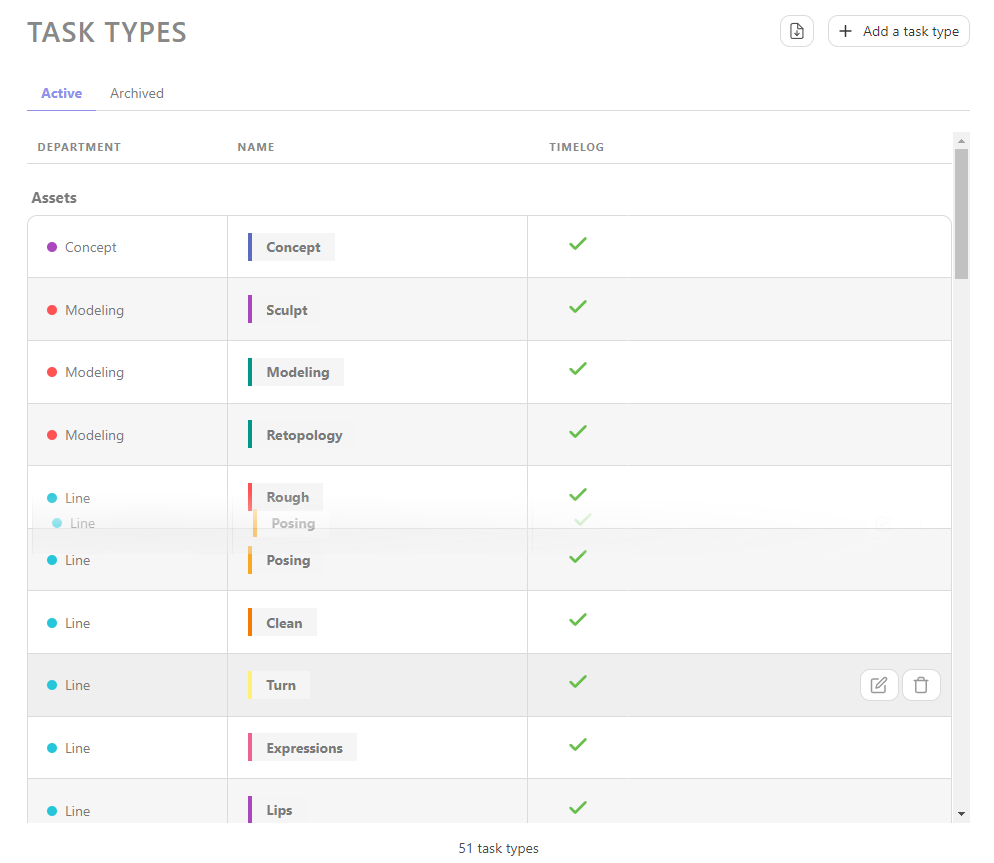
Now, your task is created on your Global Library.
WARNING
Once you have created your production, you need to add the Sequence, Episode, and Edit task types to your Production Library.
TIP
At any point during the production, you can return here and create more Task Type if needed, and then add them to your production.
# Specific Asset Types Workflow
Once you have created your global Workflow, you should be more specific about the assets.
Assets need to be organized, as the shots are organized per sequence. Think about the Asset Type as folders to keep all your assets gather per family.
On the main menu select the
ASSET TYPES page under the Admin section.
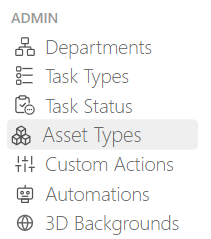
TIP
By default, Kitsu already provides some examples of asset types for CGI production.

If you need more Asset Type, click on the button.
On the new pop-up, you can define your personalized Asset Type:
You can choose a name
You can define a specific workflow.
All Asset Types will behave differently. For example, you may have fewer tasks for an Environment than a Character; you don't need the Rigging task.
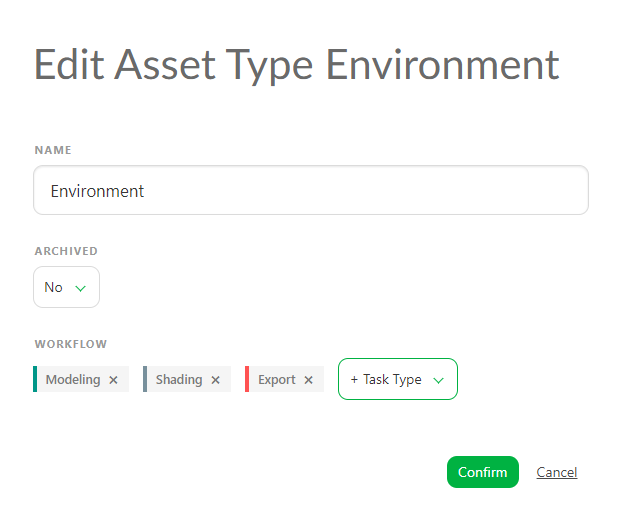
When you create or edit an Asset Type, you can add a specific task type; if you don't select a specific workflow for this asset type, your production asset workflow will be applied.
However, if you choose specific Task types for this Asset type, only these will be applied to production.
Click on Confirm to save your changes.
Your new Asset Type is now created on your Global Library. It will be available when you create your production.
TIP
At any point during the production, you can return here and create more Asset Type if needed, and then add them to your production.
# Approval Workflow: Task Status
Let's create all the statuses we need during our Approval Workflow.
The main point is to determine the situation behind the Status.
On the main menu select the
TASK STATUS page under the Admin section.
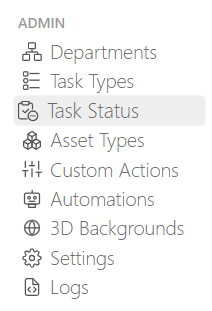
TIP
Kitsu already provides examples of Task Status.
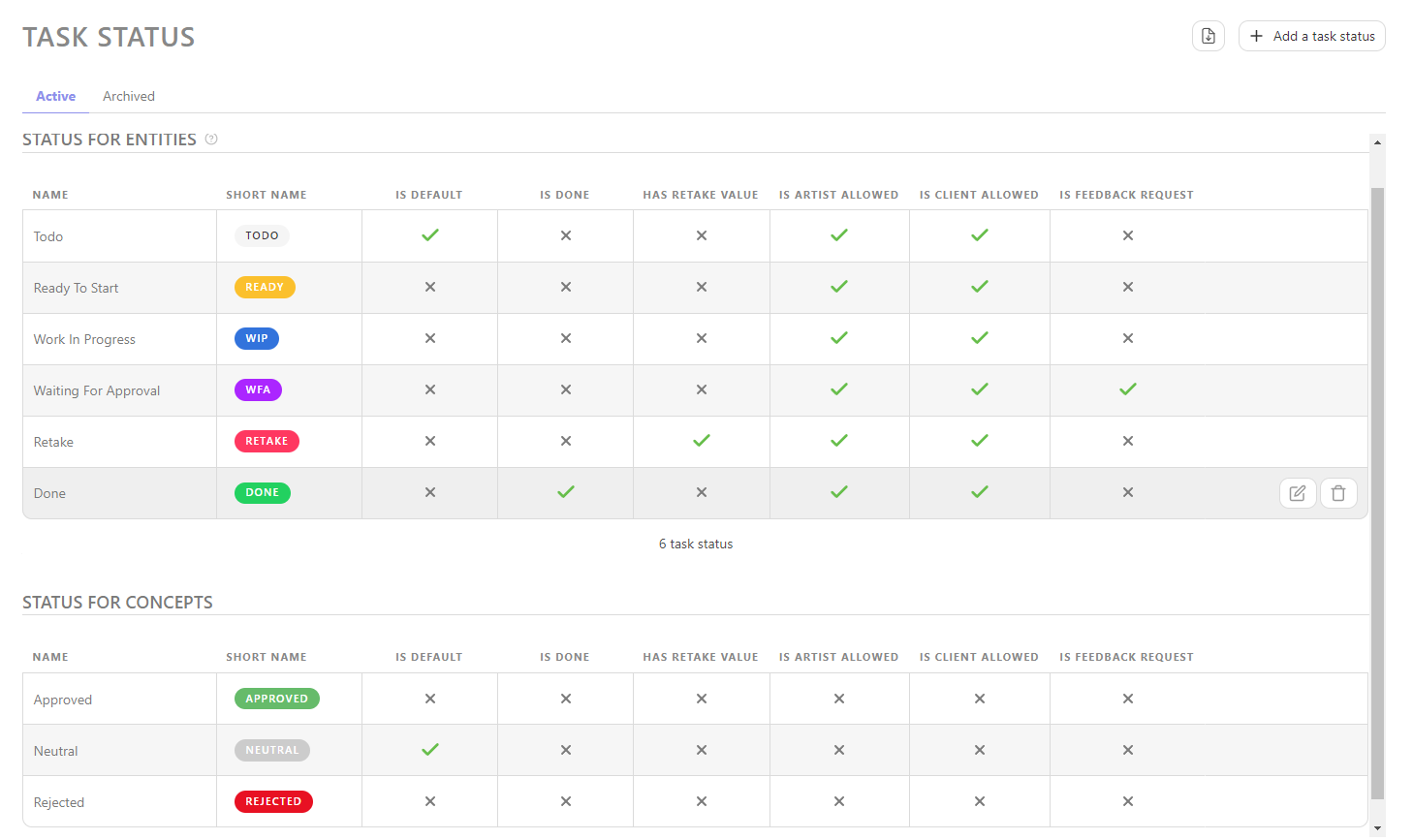
For example, the Ready status. In our example, it means that the artists have everything
they need to start working, and shouldn't start their work without.
Wip : Work in Progress status is used by the artists to let their team and producer
they are actively working on the task right now, so there is no need to assign it to someone else.
WFA: The waiting-for-approval Status is used by the artists to let their supervisors know that they have finished their work and are waiting for a review.
The supervisor can also use an alternative to this Status to let the directors know that everything is ready for them.
Done : Everything is validated. Congrats, and the next step can begin.
Retake : A comment is made; the artists need to keep working on their work and publish a new version until validation.
These Status are the only examples of what is doable in Kitsu. Feel free to create your own.
On the main page, click on the button.
On the new pop-up, you can define your personalized Task Status.

- NAME, the explicit name of the Status that will be displayed if you keep your mouse on top of the Status.
- SHORT NAME, what will be displayed in Kitsu
- IS DEFAULT, the first Status Kitsu will display per default on all the tasks. You can have only ONE default status in Kitsu.
- IS DONE: If this Status is used to validate a task (useful for the quota, to clean the todo list, and episode stat page)
- HAS RETAKE VALUE If this Status is used to comment on a task (useful to keep track of the back and forth in the task type page and for the episode stats page)
- IS ARTIST ALLOWED Can the artist use this Status? If No, the artist won't see this Status on his list. But he can post on top of it.
- IS CLIENT ALLOWED Can the client use this Status? If No, the client won't see this Status on his list
- IS FEEDBACK REQUEST If this Status is used to ask for a review (useful to keep track of the quotas if you don't use a timesheet, it will appear in the Pending tab of the todo list, and all these statuses will be gathered on the My Check page. Kitsu will ask you to publish a preview each time you use this Status.
- Choose a background COLOR you like for this status
Click on Confirm to save your changes.
Your Status is now created on your Global Library and will be available when you create your production.
TIP
At any point during the production, you can return here and create more Task Status if needed, and then add them to your production.
WARNING
Notice that you can modify Concept Status here but can't create a new one.
# Automation
# Create a New Status Automation
Status Automation is here to do the heavy lifting for you.
You can create Status Automation for the asset and the shot tasks.
For the Asset, you can create Status Automation between tasks. For example, the modeling status must be ready when the Concept is validated.
You can also create Status Automation that changes the Asset Status according to a task status; for example, when the Concept is validated, the asset is ready for the storyboard.
TIP
You can also ask Kitsu to copy the latest preview with the Automation.
Go to the main menu and select Automation.

Once on the new page, you can create Status Automation by clicking the +Add status automation button.

You can choose between creating Status Automation for the asset or the shot.
Then, you can choose the task type and the Status that will trigger the Automation.
Then, you can select which Task Type will react to the Automation and choose the Status that will be changed.
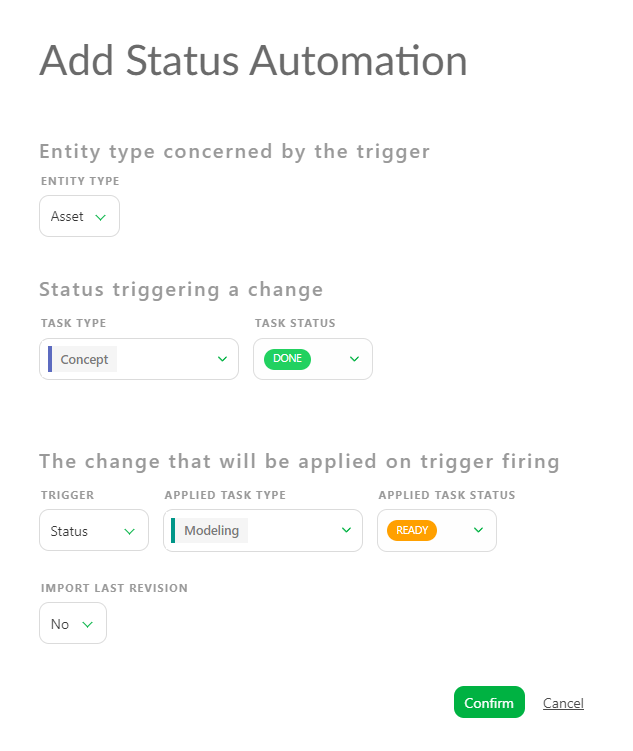
You need to change the trigger from Status to Ready Forto trigger the change in ** Ready For ** status.
You will notice the Applied task type will now display Shot task type.

To create Status Automation for shots, you must change the Entity Type to shots.
Your new Status Automation is now created on your Global Library.
WARNING
You must add them to your Production Library once you have created your production.
TIP
At any point during the production, you can return here and create more Status Automation if needed, and then add them to your production.
# 3D Backgrounds
# Create your global library of HDR files
The 3D Backgrounds help you review your 3D file (.GLB) better by adding an .HDR background.
.GLB is a binary file format, essentially a container for various 3D assets and resources. These assets can include 3D models, textures, materials, and animations.
Definition
It means you can review your 3D files with lighting information.
In this section, you can create your own. .HDR files library that you can use in your production.
Go to the main menu , and select 3D Backgrounds.
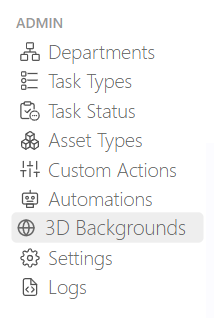
Once on the new page, you can add a .HDR Background by clicking the +Add a new background button.

From here, you must select your .HDR Background, name it, and choose if you want this .HDR to be the default Background.
TIP
Default means this HDR will be applied on the production instead of the grey background.

Once you have uploaded all your .HDR files, Kitsu will display them as a list.
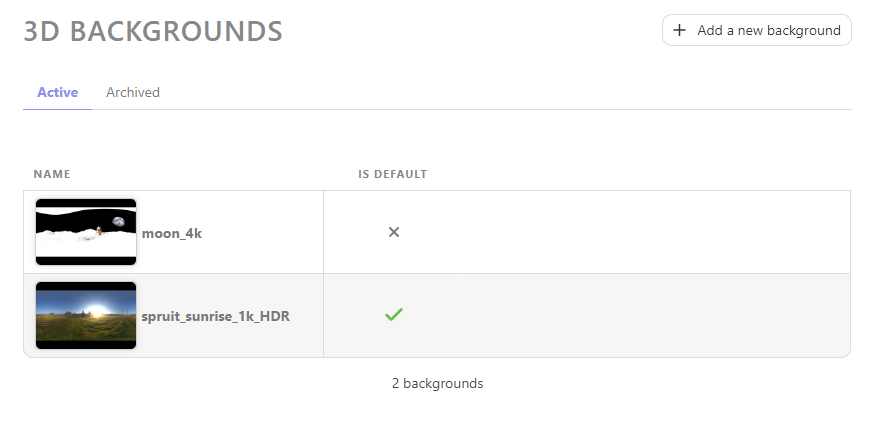
Your new 3D Background is now created on your Global Library.
WARNING
You must add them to your Production Library once you have created your production.
# Change the Logo and Kitsu Setting
The next thing to do is set the logo on the main menu.
You can change the Kitsu logo for your studio logo.
Click on the main menu button
, then under the Admin section, click on the Settings.

TIP
Here, you will manage Kitsu's global settings.
Click on the Set studio logo to select a picture.
You can also change the Studio Name.
You can change settings at the Kitsu / Studio level, impacting your whole studio.
- How many hours per day should your team work?
- You can choose to use the original file name for downloads.
- Show the picture with HD quality by default. Use this option only if you have a very fast internet connection.
- About the timesheet, you can also lock the artists to modify their timesheets older than one week.
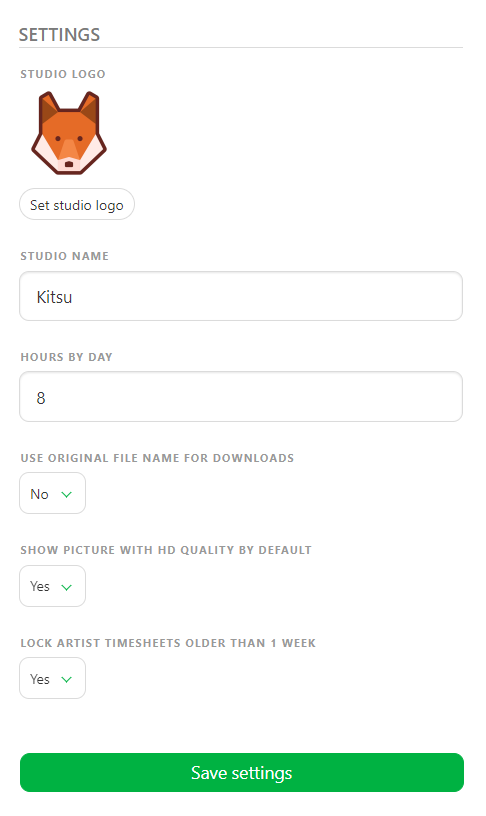
You will also find the settings linked to the chat integration. Please refer to the DEV section for more.
WARNING
Remember to Save Settings at the end when you are done.